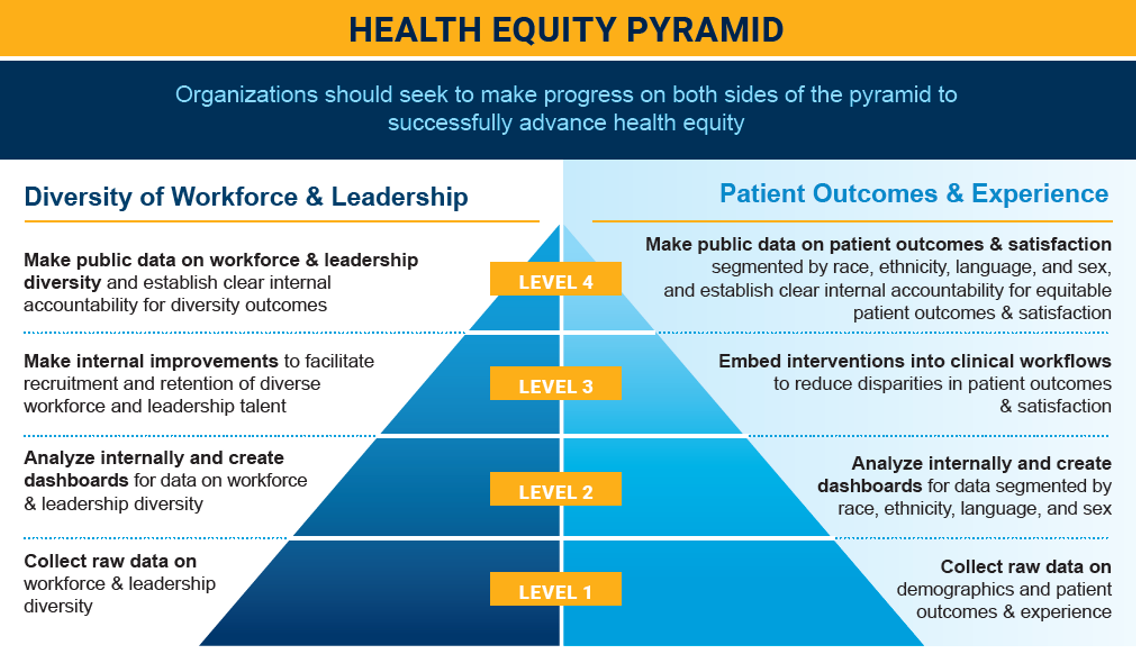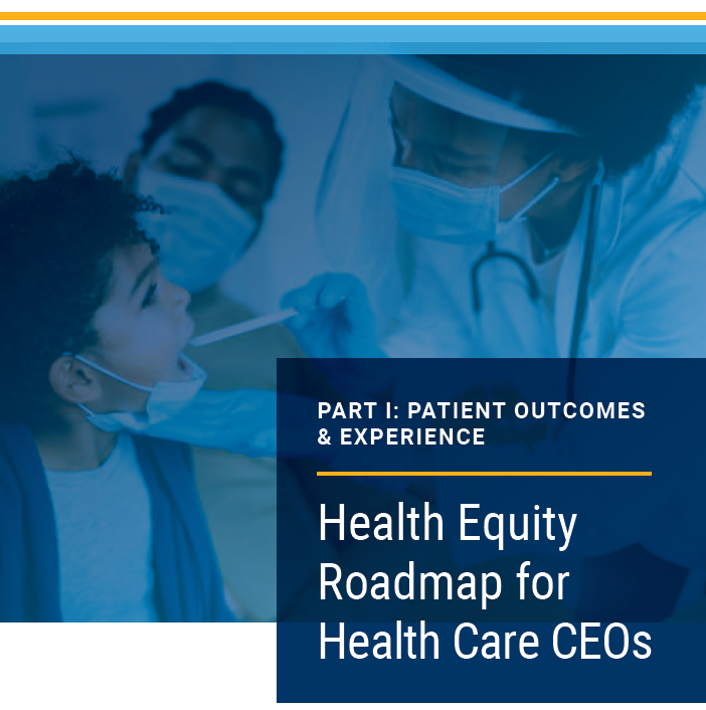Many in health care publicly discuss their commitment to reducing disparities, but fewer organizations have actually adopted a methodical approach in identifying, quantifying, and taking action to address those disparities.
With this reality in mind, Health Evolution Forum Fellows participating in the Work Group on Leveraging Data to Improve Health Equity, along with members of the larger Forum team, have created a new guide outlining actionable steps that health care CEOs can take to advance health equity on an enterprise level.
The Health Equity Roadmap for Health Care CEOs – Part I: Patient Outcomes & Experience, underwritten by Change Healthcare, was created to provide a cross-sector guide for organizations that are seeking to develop an effective and data-driven enterprise-wide strategy to advance health equity. The two-part guide is designed to help CEOs and other health care executives lead their organizations through the levels of the Health Equity Pyramid.

“Health Evolution did a survey of some member companies and we found that about 90 percent or more are actually collecting this [raw] data. But as you move up the pyramid, then you see fewer organizations actually analyzing it internally, developing dashboards, embedding it into clinical workflows, and making it public,” says Laurie Zephyrin, MD, who is a co-chair of the Work Group on Leveraging Data to Improve Health Equity, and Vice President, Delivery System Reform, The Commonwealth Fund.
Join the Pledge
Along with the guide, the Health Evolution Forum Work Group on Leveraging Data to Improve Health Equity is asking leading health care organizations to join its three-part Pledge to reduce disparities in access, care, and outcomes more strategically by collecting and stratifying race, ethnicity, language and sex (REaLS) data across top quality and access metrics. Specific goals for Pledge participants include:
- Collect REaLS data for at least 50 percent of the organization’s patient, member, or customer population.
- Stratify and regularly review these collected data by the top-priority quality or access metric for 90 percent of major business lines and/or departments/divisions of adequate size.
- Participate in the Health Evolution Health Equity Learning Lab by sharing stratified data for select measures to facilitate anonymized benchmarking and to identify best practices for reducing disparities.
Join other leading payer, provider and life science organizations who have already committed to this Pledge. More info here.
Part 1: Patient Outcomes & Experience
Those who commit to the Pledge can use the Health Equity Roadmap as operational guidance to fulfilling these impactful goals. Part two of the guide, set to be released at a later date, will focus on diversity of workforce & leadership, the left side of the pyramid, while part one focuses on the right side, patient outcomes & experience. The roadmap includes real-world examples of how organizations are using this process to reduce disparities, along with checklists and more resources CEOs can consider.
“This roadmap provides some really wonderful examples of what organizations are doing along this trajectory, how to make the dashboards clear and share them with the C-suite, and how to create equity councils to ensure not only that you are collecting the data, but also that there’s accountability for this as well,” Zephyrin added.
On both sides of the pyramid, organizations should (1) put in systems to collect necessary raw data, (2) analyze the data internally and create dashboards, (3) embed interventions into clinical workflows or HR processes, and (4) make the data public and establish clear internal accountability for equitable outcomes.
The first part of the Roadmap, Patient Outcomes & Experience, includes how to progress through the four levels of the right side of the pyramid:
- Level 1: Collect raw data on demographics and patient outcomes & experience.
- Level 2: Analyze internally and create dashboards for data segmented by race, ethnicity, language, and sex.
- Level 3: Embed interventions into clinical workflows to reduce disparities in patient outcomes & experience.
- Level 4: Make public data on patient outcomes & experience segmented by race, ethnicity, language and sex, and establish clear internal accountability for equitable patient outcomes & experience.
Fellows in the Forum say the Roadmap is applicable for health care organizations across the payer, provider and life sciences sectors. “It was important for us to figure out how to address this issue in ways that could resonate with everybody in our health care system, because our health care system doesn’t exist outside the void of the social polarization in our country,” said Mark Smith, MD, Founding President & Former CEO, California Health Care Foundation and co-chair of the Forum Roundtable on Community Health and Advancing Health Equity. “Equity is not separate from quality, it is part of quality. One doesn’t have to necessarily agree with my definition of social justice or yours to have equity as a professional aspiration and goal to which we hold ourselves and our institutions accountable because it’s a part of quality.”
DOWNLOAD THE REPORT










